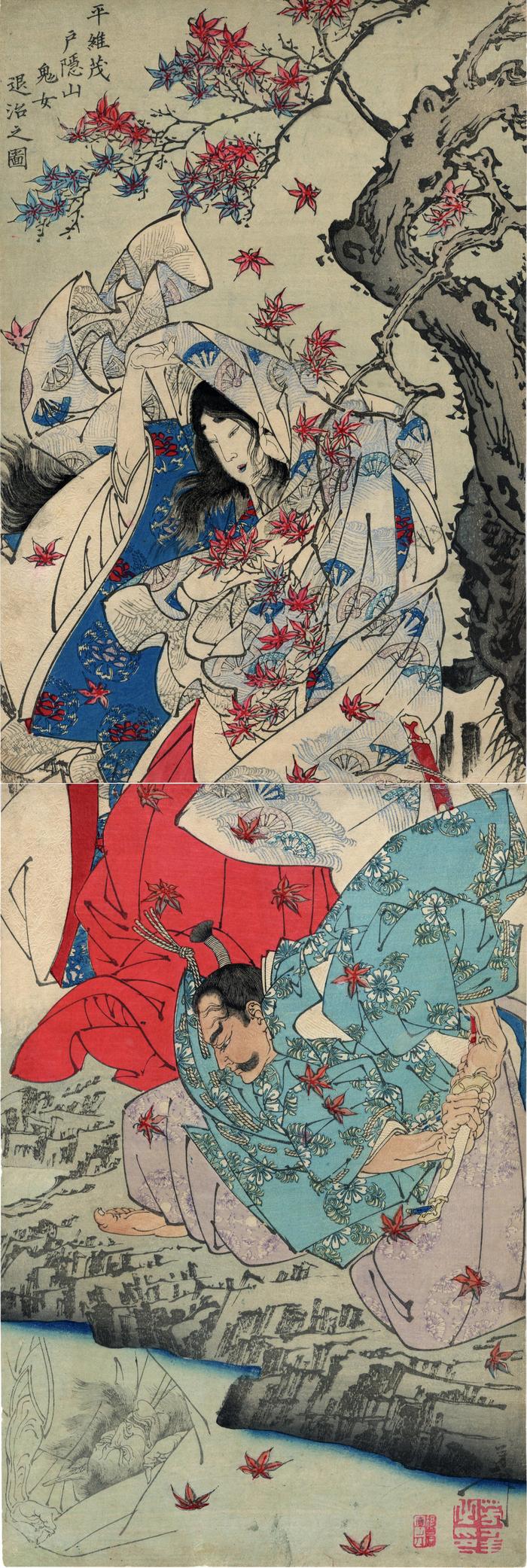Tsukioka Yoshitoshi (月岡芳年) (artist 04/30/1839 – 06/09/1892)
Taira no Koremochi Vanquishes a Female Demon at Togakushi Mountain (Taira Koremochi Togakushiyama kijo taiji no zu - 平維茂戸隠山鬼女退治之図)
1887
9.5 in x 14.5 in (Overall dimensions) Japanese woodblock print
Signed: Yoshitoshi (芳年)
Seal: Yoshitoshi no in (芳年之印)
Publisher: Matsui Eikichi (Marks 307)
(seal not listed in Marks)
Carver: Negishi Chokusan tō (彫工円活)
Museum of Fine Arts, Boston
Waseda University - top panel
Waseda University - bottom panel
Keio University
Tokyo National Museum - top half
Tokyo National Museum - bottom half
National Museum of Asian Art
Art Institute of Chicago
Ishikawa Prefectural Museum of Art
Yokohama Museum of Art
Marega Collection, Università Pontificia Salesiana (via Ritsumeikan University) - top half
Marega Collection, Università Pontificia Salesiana (via Ritsumeikan University) - bottom half
The Library of Congress - the top half only Taira no Koremochi (883-953) sees the demonic reflection of the devil-woman reflected in the waters on Mount Togakushiyama.
Henri Joly in Legend in Japanese Art is the one who gives the dates 883-953 on page 192. Most other sources don't give specific dates. E. Papinot in his Historical and Geographical Dictionary of Japan gives no dates, but says that Koremochi died at the age of 80. Of course, this does not agree with Joly's dates.
****
One autumn in the early 10th century, Taira no Koremochi went hunting in the mountains north of Kyoto, where he encountered a princess having a picnic with her servants. Joining in the revelry, Koremochi was soon intoxicated and fell to sleep. Hachiman, the God of War, came to him in a dream to warn him that the princess was actually the evil demon of Togakushi mountain. He gave Koremochi a sword and commanded him to awaken. Koremochi woke to find the demon about to devour him. He drew the magic sword and dispatched the demon.
****
Yoshitoshi dealt with this subject three times. "More typical of his mature style, this print opts for a more delicate, suggestive treatment. Here, at the moment before the bloodshed, Yoshitoshi plays with the bipolarities of illusion and reality, depicting Koremochi as he peers at the demonic reflection of the princess in a mountain pool."
Quoted from: Yoshitoshi: The Splendid Decadent by Shinichi Segi, p. 140. There is a small black and white illustration on page 139.
****
There is a copy of the top panel in the Nagano Prefectural Museum of History. The full composition can be found in the Worcester Art Museum.
****
Illustrated:
1) In color in Ukiyoe Museums in Japan (Nihon no ukiyoe bijutsukan - 日本の浮世絵美術館), vol. 1, p. 38. This example is from the collection of the Sendai City Museum (仙台市博物館)
2) In color in a one-third-page reproduction in Yoshitoshi: The Splendid Decadant by Shinichi Segi, p. 74.
3) In black and white in Chimi moryō no sekai : Ukiyoe : Edo no gekiga--reikai, makai no shujinkō-tachi (浮世絵魑魅魍魎の世界: 江戶の劇画 : 霊界魔界の主人公たち) by 中右瑛 (Nakau Ei), Ribun Shuppan, Tokyo, 1987, p. 50.
4) in color in Japanese Yōkai and Other Supernatural Beings: Authentic Paintings and Prints of 100 Ghosts, Demons, Monsters and Magicians by Andreas Marks, Tuttle Publishing, 2023, p. 209. This exact diptych is the one illustrated in this volume.
5) in a small black and white Yoshitoshi: The Splendid Decadent by Shinichi Segi, Kodansha, 1985, page 139.
Matsui Eikichi (松井栄吉) (publisher)
warrior prints (musha-e - 武者絵) (genre)
Yūrei-zu (幽霊図 - ghosts demons monsters and spirits) (genre)
Kakemono-e - 掛物絵 (genre)
Taira no Koremochi (平維茂) (role)
